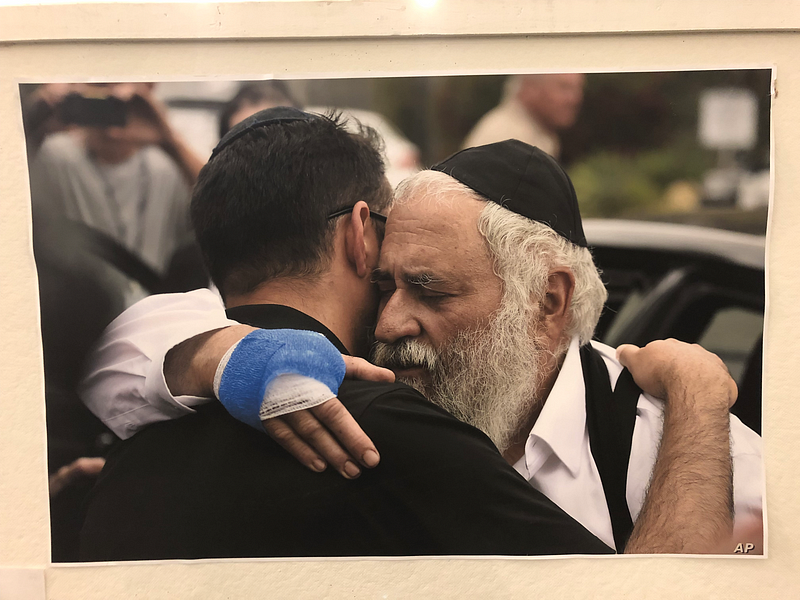
On Monday, Sept. 9th, a portion of the Kirner-Johnson (KJ) Atrium was transformed into the Contemporary Anti-Semitism exhibit, a collection of photos and informational blurbs detailing the prominence of anti-Semitism in today’s world.
The exhibit is meant to remind viewers that anti-Semitism is not just a relic of the past but a form of deadly prejudice that continues to permeate our society today.
Upon entering the exhibit, viewers are faced with posters depicting anti-Semitic propaganda, including pictures from various anti-Semitic marches and gatherings and deragatory cartoon drawings. Accompanying these images is text defining anti-Semitism and explaining its influence on current events like the Unite the Right rally in Charlottesville in 2017 and movements organized by Holocaust deniers. According to one of the exhibit’s informational blurbs, which cites the Anti-Defamation League (ADL), anti-Semitism is actually on the rise in the present day, with FBI data showing that “Jews are the religious group most frequently subjected to hate crimes.”
Detailing the inspiration behind and importance of bringing this exhibit to campus, Rabbi Didy Waks, co-director of Chabad of Clinton, said, “I spoke to my colleague who runs a Chabad that serves the Vassar community. When he told me they put on an exhibition spotlighting the rise of contemporary antisemitism, I immediately thought that is something students at Hamilton, and everywhere, need to see.
“Anti-Semitism has many different forms. Even many people who are not anti-Semitic still hold many troubling beliefs about Jews. To see some of these examples in an exhibit like this, would confront people with the reality. Jews have been ‘othered’ for millennia, and, in many ways, are still today.”
Duncan Freeman ’22 and Nikki Eisenberg ’21 are the two students responsible for bringing the exhibit to campus. Freeman said that he and Eisenberg viewed the exhibit as “a great opportunity to educate the Hamilton campus and draw special attention to the issue of anti-Semitism that we both felt wasn’t being talked about enough. From the beginning, we wanted the exhibit to be in as a public place as possible in order to get the most people there as possible.”
For both Freeman and Eisenberg, the issue of anti-Semitism is not just one of academic interest but one that is felt on a personal level as well.
“I was really woken up by the shooting at the Tree of Life Synagogue in Pittsburg,” said Eisenberg. “I went to a talk back in New Jersey soon after the shooting, which focused a lot on anti-Semitism on college campuses. It opened my mind to how other people think and feel about Judaism as a religion and culture. Until then, I felt like anti-Semitism was something my parents and grandparents talked about, or I read about happening in European countries and elsewhere.
“Last year is when it started to resonate with me, the small slights and actions continuously happening, and culminating to catastrophic events, like the Tree of Life shooting and the Charlottesville Neo-Nazi march.”
Freeman notes the personal effect of current events as well, saying, “In the last few years, anti-Semitic attacks have increased a huge amount around the world and in many places where Jews felt relatively safe they now cannot. In New York City, where I’m from, assaults of visibly Jewish people have shot up in the first half of this year with many Orthodox Jews being beaten up while simply going about their daily lives in Brooklyn.”
Both students also wanted to emphasize that the purpose of this exhibit is to be informative and not to make a political statement.
“Anti-Semitism is not reserved for one political party or type of person,” said Freeman. “It is a prejudice that is pushed by white nationalists, mainstream conservatives, liberal politicians, and left-wing college students of all different ethnicities and creeds.”
Eisenberg agrees. “It was never about being political, it’s about exposing deeply ingrained discrimination that is too often overlooked in our 21st-century society,” she said. “I think it is important to remember that unfortunately, anti-Semitism does not just live in our textbooks and grandparents’ stories. It is persistent in local communities, colleges, governments, and especially online, particularly on social media platforms.
“With the bright community we have here at Hamilton College, Duncan and I are hoping people will learn from the exhibit and engage in new and forward-thinking conversations.”
The exhibit’s goal of educating the campus community and inspiring greater awareness of modern anti-Semitism is clear, and Rabbi Waks highlighted the student leadership involved in organizing the exhibit.
“I am very proud of Hamilton students for leading the way in this project,” he said. “And seeing so many students examining all the pictures and taking it all in is very reassuring.”
In addition to Freeman, Eisenberg, and Waks, Chabad of Hamilton, Hamilton Hillel, Director of Student Activities Noelle Niznik, and Professor of History Shoshana Keller also played key roles in organizing, planning, and contributing to the exhibit.
The Contemporary Anti-Semitism exhibit remain on display until Friday, Sept. 13th. All community members are welcome and encouraged to stop by the KJ Atrium to view it.

















